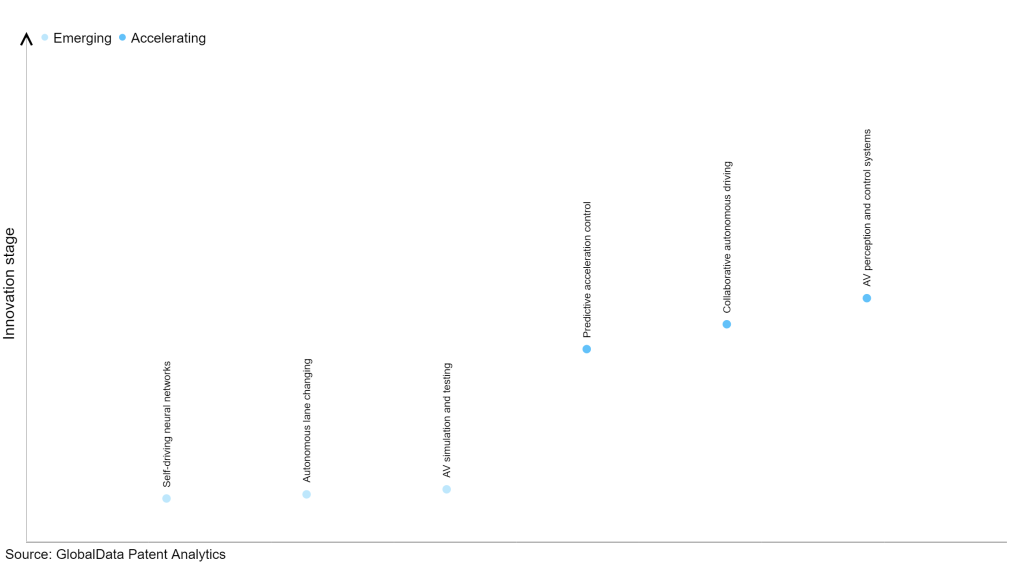The automotive industry continues to be a hotbed of patent innovation. Activity is driven by the need to improve driving experience and safety, and growing importance of technologies such as robotics, cloud computing and Internet of Things. In the last three years alone, there have been over 720,000 patents filed and granted in the automotive industry, according to GlobalData’s report on Artificial intelligence in automotive: road slope estimation. Buy the report here.
However, not all innovations are equal and nor do they follow a constant upward trend. Instead, their evolution takes the form of an S-shaped curve that reflects their typical lifecycle from early emergence to accelerating adoption, before finally stabilizing and reaching maturity.
Identifying where a particular innovation is on this journey, especially those that are in the emerging and accelerating stages, is essential for understanding their current level of adoption and the likely future trajectory and impact they will have.
300+ innovations will shape the automotive industry
According to GlobalData’s Technology Foresights, which plots the S-curve for the automotive industry using innovation intensity models built on over one million patents, there are 300+ innovation areas that will shape the future of the industry.
Within the emerging innovation stage, self-driving neural networks, autonomous lane changing and AV simulation and testing are disruptive technologies that are in the early stages of application and should be tracked closely. Predictive acceleration control, collaborative autonomous driving, and AV perception and control systems are some of the accelerating innovation areas, where adoption has been steadily increasing.
Innovation S-curve for artificial intelligence in the automotive industry

Road slope estimation is a key innovation area in artificial intelligence
Road slope estimation, which includes lateral slope estimation and longitudinal slope estimation, is beneficial in many aspects. Lateral slope (roll angle) implies the angle between the axis of road width and the earth's horizontal plane. Lateral slope estimation can be utilised in a lane keep assist (LKA) system to keep a car in the lane and speed control to navigate a curve safely.
GlobalData’s analysis also uncovers the companies at the forefront of each innovation area and assesses the potential reach and impact of their patenting activity across different applications and geographies. According to GlobalData, there are 210+ companies, spanning technology vendors, established automotive companies, and up-and-coming start-ups engaged in the development and application of road slope estimation.
Key players in road slope estimation – a disruptive innovation in the automotive industry
‘Application diversity’ measures the number of applications identified for each patent. It broadly splits companies into either ‘niche’ or ‘diversified’ innovators.
‘Geographic reach’ refers to the number of countries each patent is registered in. It reflects the breadth of geographic application intended, ranging from ‘global’ to ‘local’.
Patent volumes related to road slope estimation
Source: GlobalData Patent Analytics
Hyundai Motor is a key player in the area of road slope estimation innovation. The system consists of a signal processor that receives a raw signal containing data on acceleration and rotational velocity sent from a 6 degrees of freedom (GNSS/INS) inertial sensor, and a vehicle motion estimator that computes the overall angles of a vehicle based on the signals from the GNSS/INS inertial sensor filtered by the signal processor and on vehicle measurement information sent from a vehicle sensor. Porsche Automobil, Kia, Toyota, and Ford Motor are some of the other key players.
In terms of application diversity, Toshiba held the top position, while Fathym and Baidu stood in second and third positions, respectively. By means of geographic reach, Land Rover leads the pack, followed by TomTom and Intel.
To further understand how artificial intelligence is disrupting the automotive industry, access GlobalData’s latest thematic research report on Artificial Intelligence (AI) in Automotive.
Data Insights
From

The gold standard of business intelligence.
Blending expert knowledge with cutting-edge technology, GlobalData’s unrivalled proprietary data will enable you to decode what’s happening in your market. You can make better informed decisions and gain a future-proof advantage over your competitors.



